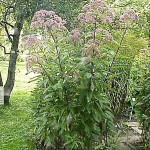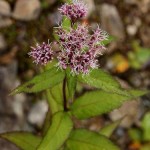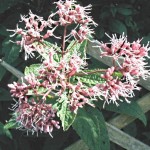Gravel Root – Eupatorium purpureum
|
Current Demand = GOOD |
Parts Used: Rhizome & Root |
 |
 |
 |
 |
Family: Compositae
Common Names: Queen of the Meadow, Joe-pye weed, jopiweed, kidney root, kidneywort, purple boneset, trumpet weed, gravelweed, hempweed…
Description
This stately herb has whorls of three to six leaves that have a faint scent of vanilla or apple peel, and pink flowers in late summer. The woody, thick and purplish brown with cream colored flesh fibrous rootstock produces one or more hollow stems, and marked with purple where leaves are attached. The leaves grow in whorls of four to six and the flower heads of six to seven flowers, varying from purple to whitish, grow in clusters from August to September. It prefers to grow in the meadows, woodlands, dappled shade and shady edges.
Growing Region
Gravel root is found in the Eastern U.S. and Nova Scotia. It is common through out the Southern Midwest states and Appalachia west to Oklahoma.
Harvesting/Drying
Parts Used: rhizome and root
Ready for harvest and can be collected in late summer and autumn, when the plant has stopped flowering. The leaves and flowering stems are harvested in the summer before the buds open and are dried for later use. The roots do better if dug after the first frost. Generally only the plants roots have market value though occasionally the tops can be sold early in the growing season before the flower matures. Gather the larger more mature plants, leaving plenty of younger plants to seed the area for future harvest.
After harvest, the roots should be washed in cold water and foreign material (rocks, dirt and other roots) must be removed. Splitting the roots when fresh will help with cleaning and drying. Unless your buyer is purchasing fresh dug roots (which they often do) the clean roots need to be dried. Large roots may need to be broken in half to aid in drying. Gravel root can be dried in the sun although if possible dry indoors in a well ventilated barn loft or attic to protect from the elements. If natural heat is not available, you may need to add heat to a room and a fan for continuous airflow. The key to drying any root herb, or bark is an even combination of heat and airflow.
Never dry in an oven or microwave. Once the roots are completely dry (largest root will snap not bend) in approximately 5-10 day, depending on the size of the root and drying conditions. Place roots carefully into a cardboard box, paper bag or burlap bag for storage in a dry area until ready to sell or use. Do not store in plastic as it will mold.
Planting/Cultivation:
The Gravel Root prefers a well-drained but moisture retentive in sun or part shade. Cut plants to the ground in late winter. It is best propagated by stem cuttings.
The plant prefers light (sandy), medium (loamy) and heavy (clay) soils and requires well-drained soil. The plant prefers acid, neutral and basic (alkaline) soils. It can grow in semi-shade (light woodland) or no shade. It requires moist soil.
Seed – sow spring in a cold frame and only just cover the seed. Prick out the seedlings into individual pots when they are large enough to handle and plant them out into their permanent positions in the summer. Division in the spring or autumn by clumps and replant directly into the permanent positions.
Attributes (Images)
Permission granted to use under GFDL by Kurt Stueber
By Kurt Stüber [1] [GFDL or CC-BY-SA-3.0], via Wikimedia Commons
By Tatters ❀ from Brisbane, Australia (Eupatorium purpureum) [CC BY-SA 2.0], via Wikimedia Commons
 Root Buyer
Root Buyer